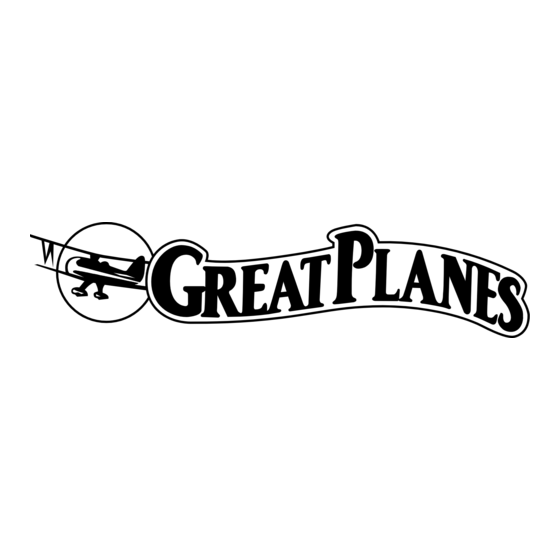GREAT PLANES EXTRA 330SC Gebruiksaanwijzing - Pagina 17
Blader online of download pdf Gebruiksaanwijzing voor {categorie_naam} GREAT PLANES EXTRA 330SC. GREAT PLANES EXTRA 330SC 20 pagina's. Model aircraft great planes extra 330sc

Balance Propellers
Carefully balance your propeller and spare propellers before
you fl y. An unbalanced prop can be the single most signifi cant
cause of vibration that can damage your model. Vibration
of props on small models can cause a loss of power, but
vibration may also damage your radio receiver, battery and
possibly the motor bearings.
®
We use a Top Flite
Precision Magnetic Prop Balancer
(TOPQ5700) in the workshop and keep a Great Planes
Fingertip Prop Balancer (GPMQ5000) in our fl ight box.
Ground Check and Range Check
Always ground check the operational range of your radio
before the fi rst fl ight of the day following the manufacturer's
instructions that came with your radio. This should be done
once with the motor off and once with the motor running
at various speeds. If the control surfaces do not respond
correctly, do not fl y! Find and correct the problem fi rst. Look
for loose servo connections or broken wires, corroded wires
on old servo connectors, poor solder joints in your battery
pack or a defective cell, or a damaged receiver crystal from
a previous crash.
MOTOR & BATTERY SAFETY
PRECAUTIONS
Failure to follow these safety precautions may result in
severe injury to yourself and others.
Do not run the motor in an area of loose gravel or sand; the
propeller may throw such material in your face or eyes.
Keep your face and body as well as all spectators away
from the plane of rotation of the propeller as you start and
run the motor.
Keep these items away from the prop: loose clothing, shirt
sleeves, ties, scarfs, long hair or loose objects such as
pencils or screwdrivers that may fall out of shirt or jacket
pockets into the prop.
The motor can get hot! Do not touch it right after operation.
Once the motor battery is plugged in to the ESC, stay clear
of the propeller. The motor could start at any time.
LITHIUM BATTERY HANDLING
AND USAGE
WARNING!! Read the entire instruction sheet included with
your battery. Failure to follow all instructions could cause
permanent damage to the battery and its surroundings,
and cause bodily harm!
ONLY use a LiPo approved charger. NEVER use
a NiCd/NiMH peak charger.
NEVER charge in excess of 4.20V per cell.
ONLY charge through the "charge" lead. NEVER
charge through the "discharge" lead.
NEVER charge at currents greater than 1C.
ALWAYS set the charger's output volts to match
the battery volts.
ALWAYS charge in a fi reproof location.
NEVER trickle charge.
NEVER allow the battery temperature to exceed
150° F (65° C).
NEVER disassemble or modify the pack wiring in
any way or puncture the cells.
NEVER discharge below 2.5V per cell.
NEVER place the battery or charger on
combustible materials or leave it unattended
during charge or discharge.
ALWAYS KEEP OUT OF THE REACH OF
CHILDREN.
NEVER charge the battery in the plane.
ALWAYS remove the battery from the plane after
a crash. Set it aside in a safe location for at least
20 minutes. If the battery is damaged in the crash
it could catch fi re.
If the battery starts to swell, quickly move the battery to
a safe location, preferably outside: Place it in a bucket,
covering the battery with sand.
AMA SAFETY CODE (EXCERPTS)
Read and abide by the following excerpts from the Academy
of Model Aeronautics Safety Code. For the complete Safety
Code refer to Model Aviation magazine, the AMA web site or
the Code that came with your AMA license.
17
